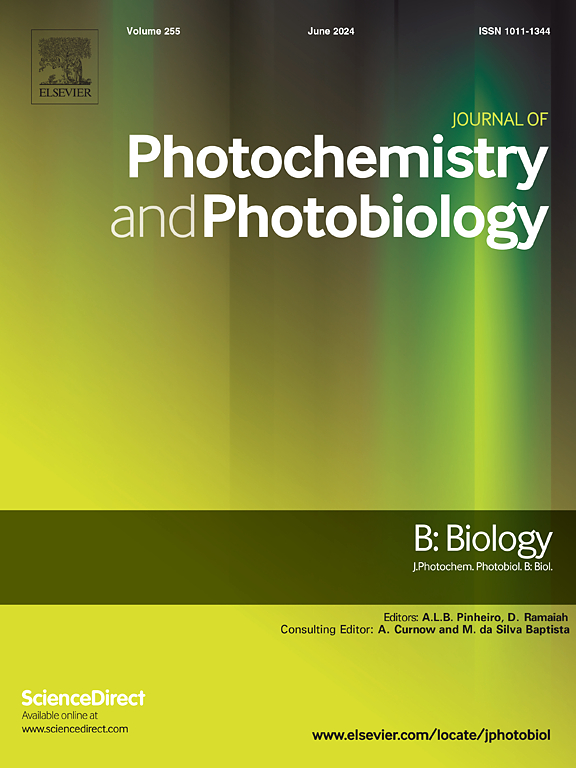Single amino acid substitution analogs of marine antioxidant peptides with membrane permeability exert a marked protective effect against ultraviolet-B induced damage
IF 3.9
2区 生物学
Q2 BIOCHEMISTRY & MOLECULAR BIOLOGY
Journal of photochemistry and photobiology. B, Biology
Pub Date : 2025-01-31
DOI:10.1016/j.jphotobiol.2025.113120
引用次数: 0
Abstract
Ultraviolet-B (UVB) causes oxidative stress, which is implicated in skin damage and photoaging. Antioxidant peptides exhibit protective effects against UVB-induced oxidative stress and are thus regarded as potential competitors compared to synthetic antioxidants for cosmetics. In the present study, we provided a discovery pipeline for screening and modifying marine-derived antioxidant peptides, and successfully identified and characterized three novel modified peptides (WP5, LW5 and YY6) with strong antioxidant abilities. Their scavenging activities on 2,2′-azinobis-(3-ethylbenzthiazoline-6-sulphonate) radical (ABTS·) and hydroxyl radical (·OH) were higher than those of glutathione (GSH) (ABTS·: 71.12 ± 3.58 %, 67.63 ± 1.65 % and 68.51 ± 0.54 % by WP5, LW5 and YY6, respectively, vs 61.51 ± 1.02 % by GSH; ·OH: 52.15 ± 1.99 %, 51.25 ± 1.29 % and 53.06 ± 2.23 % by WP5, LW5 and YY6, respectively, vs 42.69 ± 1.18 % by GSH). The modified peptides can effectively penetrate cell membrane and significantly enhance cell viability against UVB-induced oxidative stress in human keratinocyte (HaCaT) cells by reducing the levels of reactive oxygen species and malondialdehyde and increasing the activity of intracellular antioxidant enzymes, including superoxide dismutase and glutathione peroxidase. Additionally, the modified peptides decreased the expression of tumor necrosis factor-α, interleukin-6 and interleukin-1β in UVB-induced cell inflammatory response, exhibiting a potent anti-inflammatory activity. Further investigation into the molecular mechanism revealed that the modified peptides not only decreased cell apoptosis by down-regulating the apoptosis factors Bax/Bcl-2 and c-PARP, but also increased the antioxidant capacity of HaCaT cells by interrupting the interaction between Kelch-like ECH associated protein 1 (Keap1) and nuclear factor erythroid 2-related factor 2 (Nrf2), and ultimately promoting Nrf2 activation. The findings suggest a promising strategy for accelerating the discovery of antioxidant peptides and cell-penetrating peptides, providing valuable insights for pharmaceutical and cosmetic industries.
具有膜渗透性的海洋抗氧化肽单氨基酸取代类似物对紫外线b损伤具有明显的保护作用
紫外线b (UVB)引起氧化应激,这与皮肤损伤和光老化有关。抗氧化肽对uvb诱导的氧化应激具有保护作用,因此被认为是化妆品中合成抗氧化剂的潜在竞争者。在本研究中,我们为筛选和修饰海洋源抗氧化肽提供了一条发现管道,并成功鉴定和表征了三种具有强抗氧化能力的新型修饰肽(WP5, LW5和YY6)。WP5、LW5和YY6对2,2′-氮唑-(3-乙基苯并噻唑-6-磺酸盐)自由基(ABTS·)和羟基自由基(·OH)的清除率分别高于谷胱甘肽(GSH) (ABTS·分别为71.12±3.58%、67.63±1.65%和68.51±0.54%),而GSH为61.51±1.02%;·哦:52.15±1.99%,51.25±1.29%和53.06±2.23%,WP5 LW5 YY6,分别由谷胱甘肽vs 42.69±1.18%)。修饰肽能有效穿透细胞膜,通过降低活性氧和丙二醛水平,增加细胞内抗氧化酶(包括超氧化物歧化酶和谷胱甘肽过氧化物酶)的活性,显著提高人角化细胞(HaCaT)细胞抗uvb诱导的氧化应激的活性。此外,修饰肽可降低uvb诱导的细胞炎症反应中肿瘤坏死因子-α、白细胞介素-6和白细胞介素-1β的表达,显示出强大的抗炎活性。进一步的分子机制研究发现,修饰肽不仅通过下调凋亡因子Bax/Bcl-2和c-PARP来减少细胞凋亡,还可以通过阻断kelch样ECH相关蛋白1 (Keap1)与核因子红细胞2相关因子2 (Nrf2)的相互作用来提高HaCaT细胞的抗氧化能力,最终促进Nrf2的活化。这一发现为加速抗氧化肽和细胞穿透肽的发现提供了一个有希望的策略,为制药和化妆品行业提供了有价值的见解。
本文章由计算机程序翻译,如有差异,请以英文原文为准。
求助全文
约1分钟内获得全文
求助全文
来源期刊
CiteScore
12.10
自引率
1.90%
发文量
161
审稿时长
37 days
期刊介绍:
The Journal of Photochemistry and Photobiology B: Biology provides a forum for the publication of papers relating to the various aspects of photobiology, as well as a means for communication in this multidisciplinary field.
The scope includes:
- Bioluminescence
- Chronobiology
- DNA repair
- Environmental photobiology
- Nanotechnology in photobiology
- Photocarcinogenesis
- Photochemistry of biomolecules
- Photodynamic therapy
- Photomedicine
- Photomorphogenesis
- Photomovement
- Photoreception
- Photosensitization
- Photosynthesis
- Phototechnology
- Spectroscopy of biological systems
- UV and visible radiation effects and vision.

 求助内容:
求助内容: 应助结果提醒方式:
应助结果提醒方式:


